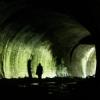I already have the basics of the track-system working, objects can have varying size (rectangular or circular) and will always be centered on a track, all track pieces are laid out on a grid... an object transitions from track to track as it moves along... splitters/mergers will be implemented via logic (transition to one of many tracks). So all track pieces are represented as single lines. Collisions should now be solvable by simply checking the distance between objects. Objects can only move in ONE predefined direction, they can never go backwards.
The short version: how do you best implement and represent locomotives/cars/objects moving on railroads/roads/conveyors?
However, I'm not sure how to best implement the collisions and representation of the objects on the tracks, also for triggers (object entered area, object fully in area, etc).
I could simply store the center point of each object, which feels like the most straight-forward approach, although I can already think of a whole heap of pitfalls with this... as what you actually want to know is where both sides of the object is on the track, it makes triggers more flexible and simpler (remember, multi-tracks and complex systems are designed as stitching and switching between "hidden" tracks with logic). But one can't "compute" both sides on an object from a single point on a track without additional state keeping, as it is very possible that the center point just went through a merger, at this point, it is impossible to know where the back is, track A or B. So then the merger would have to keep track of its "alignment" until both front and back has passed through (and it can become much more complicated), another issue here is that, packages cannot go backwards... but this method would require "looking backwards".
It seems to me that the best approach is to not insert one object, but TWO, the front and the back. And then make sure that these are always "synchronized", mergers/splitters still have to keep some state, but it comes more natural now, it checks for the front to enter and then choses a track, and simply waits for the back to come and puts it on the same track. Basically, all the logic is now internal to the track pieces.
So, as you may notice, I'm kind of debating with myself, and from what I can tell, representing an object as both the FRONT and the BACK as separate by synchronized entities on the track is the best way (there would still be a center point, but it can be computed from FRONT and BACK at any time). But I'm curious, I'm certainly not the first one to do something like this, are there other better methods, did I miss something trivial about storing the "center point"? Or am I on the right track with separate entities for FRONT/BACK? Any thoughts and comments are welcome, including if I make absolutely no sense at all
If there are any articles on this, I would be more than happy.






